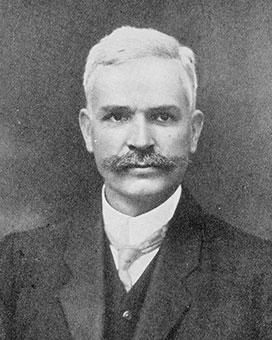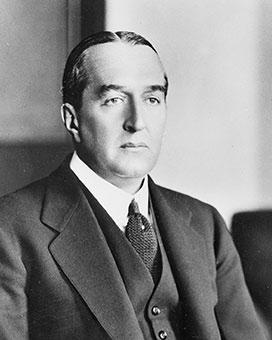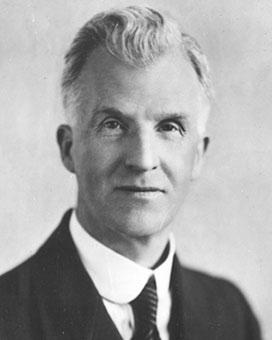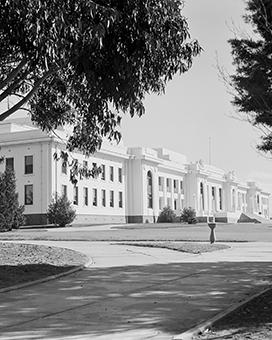Mary Hughes was a trained nurse when she and William Hughes married in 1911. From then, she accompanied him on almost all of his overseas journeys. Hughes insisted his health required her attendance on official trips. Prime ministerial spouse from 1915 to 1923, Mrs Hughes was active in welfare work in Australia, and during her years in England. In 1922 she was the second Australian woman to be awarded the Dame Grand Cross (GBE), the highest British award for women.
On 26 June 1911, Mary Ethel Campbell, then 37, married William Hughes in Melbourne. She came from a family of graziers at Burrandong near Wellington in south-western New South Wales. She had trained as a nurse and attended to Hughes’ illnesses on his overseas trips as Prime Minister in 1916, 1917–18 and 1921.
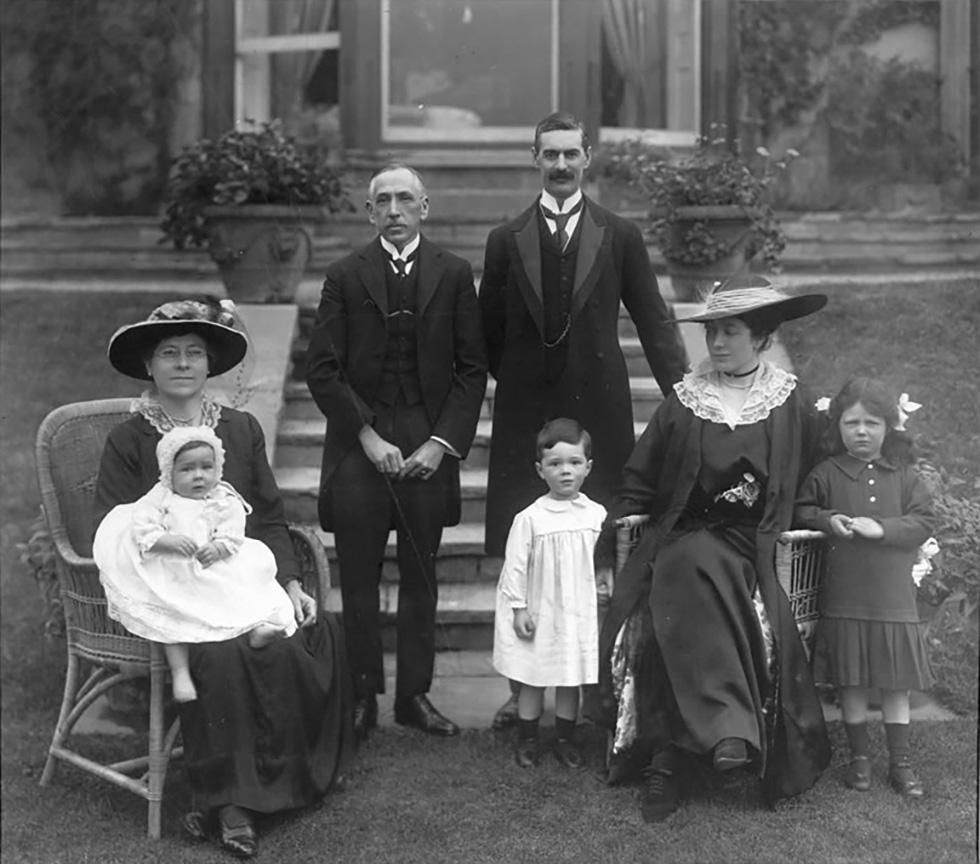
Mary Hughes with baby Helen, William Hughes, Neville Chamberlain and his family in Birmingham, England in May 1916. By permission National Library of Australia.
William and Mary Hughes spent January to July 1916 overseas. In their first month, Mrs Hughes’ official duties included being presented to Queen Mary at Buckingham Palace and giving an interview to the magazine Ladies Field. On 25 April, the Hughes, with their baby daughter, travelled to Scotland with Australia’s High Commissioner in London Andrew Fisher, Margaret Fisher and journalist Keith Murdoch. There they appeared at ceremonies in honour of their visit, and Hughes received the freedom of cities and honorary doctorates of universities.
In May, the Hughes were overnight guests of King George V and Queen Mary at Windsor Castle, and travelled in England to ceremonial welcomes at various cities. In Birmingham, the Hughes were welcomed by the family of Lord Mayor Neville Chamberlain. In London in June 1916, both the Hughes became familiar faces at the Australian Imperial Force headquarters in Horseferry Road, at the Anzac buffet at Victoria Station, and in hospitals visiting wounded Australian troops.
At the end of 1917, after the election and the bitter conscription referendum, Hughes suffered a collapse and was nursed once more by Mrs Hughes. Then on 26 April 1918, the Hughes again travelled overseas. They stopped in Vancouver en route to England and Hughes went to Washington for meetings with US President Woodrow Wilson. He was also engaged in a fierce struggle to enable his family to travel to England with him. Australian officials involved in pressing his case pointed out that his precarious health made it essential for Mrs Hughes to be available to nurse him should he fall ill. Hughes was to cross the Atlantic in a warship, but Mrs Hughes was refused permission to accompany him. She sailed from New York with 3-year-old Helen in a convoy that arrived safely in England on 15 June.
In 1917–18, the Hughes stayed in England for over a year. Mrs Hughes once more took up work for the welfare of Australian troops. She worked with Mary Cook at the ANZAC buffet, the Red Cross and in hospitals. Newspapers reported that her ‘self-sacrifice, fortitude, and zeal won for her golden opinions among our soldiers’.
In 1918–19 and during her next visit to England in 1921, Mrs Hughes developed a network of contacts that included Britain’s past and present prime ministerial wives – Margaret Lloyd George, Margot Asquith and Clementine Churchill. Mrs Hughes also became a close friend of suffragette leader Christabel Pankhurst.
In the New Year’s Day Honours in 1922, Mrs Hughes was made a Dame Grand Cross of the Order of the British Empire. She was the second Australian to receive the GBE, the highest British award for women.
When Hughes became Member of the House of Representatives for the North Sydney division in 1922, the family moved from Melbourne to the Sydney suburb of Lindfield. Mrs Hughes continued to be Hughes’ nurse and political adviser. When Prime Minister Stanley Bruce failed to appoint Hughes High Commissioner to London in 1926, she prescribed caution in discussing the matter openly. In February 1928, when he was convalescing after another bout of illness, she advised him to drop his attempts against Bruce, saying he
has worked things out so wonderfully and cemented all so firmly around him in such concrete form that it strikes me that no-one could break through the boundaries.
Instead of taking this advice, Hughes managed to topple both the Nationalist government, and Bruce himself the following year.
Mrs Hughes remained a ‘political wife’ for another 23 years. She travelled overseas with Hughes in the 1930s, and once again became an energetic war-worker during World War II.
During parliamentary terms, the Hughes stayed at the Hotel Canberra. Mrs Hughes, by that time ‘Dame Mary’, was as venerable a figure holding court there as Hughes was in the nearby Parliament House.
Mrs Hughes died in Sydney on 2 April 1958.
Sources
- Langmore, Diane, Prime Ministers’ Wives: The Public and Private Lives of Ten Australian Women, McPhee Gribble, Ringwood, Victoria, 1992.
- LF Fitzhardinge, That Fiery Particle 1862–1914, Angus & Robertson, Sydney 1964.
- LF Fitzhardinge, The Little Digger 1914–1952, Angus & Robertson, Sydney, 1979.
- Australian National Review, 24 January 1922, p. 15


